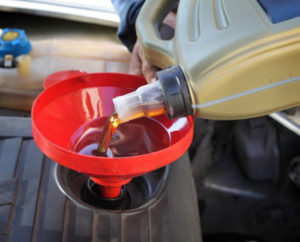How Often Should I Get a Coolant Flush?
Several components and chemicals make up the foundation on which vehicles operate. Coolant is one of the most important chemicals found in cars, because it helps prevent overheating in a very harsh, very hot environment.
Coolant is also known as antifreeze. So if you hear those two words, just know they mean the same thing. While coolant helps lower the odds of engine overheating, over time, it can cause harmful deposits to build up inside of your engine block. When this occurs, the functionality of your coolant is significantly impacted. To restore your vehicle to its best condition and operational efficiency, you need to regularly flush your coolant.
To learn more about how often you should get a coolant flush, continue reading.

How often should I get a coolant flush?
As per industry standard, it’s recommended you change your coolant every 30,000 miles. Any vehicle with less than 10,000 miles on it doesn’t require a coolant flush, at least not immediately.
Coolant reacts to the way you drive. So, if you’re continually accelerating at high speeds and driving for long periods, your coolant may require a flush much sooner.
The best way to ensure you maintain a healthy coolant is by getting a professional vehicle inspection. A reputable auto shop like Little Germany will help you determine if it’s time to change your coolant.
Take a look at this article to see more information about knowing when to change your coolant.
Failing to flush your coolant correctly can result in engine overheating. Also, you should make sure you flush your coolant regularly. Doing so ensures your vehicle runs in optimal condition for a long time.
Flushing your coolant involves several steps. First, the engine must be cool before flushing the coolant. You don’t want to park it after a drive and make the attempt. Next, you need to jack the car up on a stand. After that, make sure you clean and perform an inspection of your radiator. Once complete, the process of flushing your coolant can begin. Flushing a coolant system with no prior experience is challenging. So, you should contact a professional mechanic to assist you.
Here is an article you can look at to learn more about the process involved with flushing coolant systems.
Getting the most out of your coolant
To prolong the life of your engine, maintaining healthy coolant is vital. To get the most out of your coolant, there are some simple driving tips you should follow. First, try to maintain a steady speed when driving. Fluctuations in speed can have a significant impact on the longevity of your coolant. By maintaining a consistent driving pattern, you can get longer and better performance from your coolant. Also, get routine vehicle inspections to check the condition of your coolant. Doing so enables you to keep a close eye on how well your engine is performing.
People Also Ask
Q: Is coolant flush necessary?
A: Yes, but only for vehicles with more than 30,000 miles. New cars with less than 10,000 miles don’t require a coolant flush.
Q: How much should a coolant flush cost?
A: On average, you can expect to pay anywhere from $100-$150 for a coolant flush. It all depends on the type of coolant used and the type of vehicle.
Q: Why does coolant need flushing?
A: Coolant flushes remove large amounts of harmful deposits and debris from your engine. This reduces the odds of overheating.
Let Little Germany Flush Your Coolant The Right Way!
To start your coolant flush, contact Little Germany today. Let their team help you get started with the process. They’ll help you choose the right replacement coolant while also informing you about all of the steps involved with the process.
